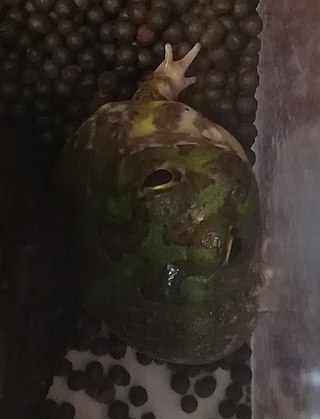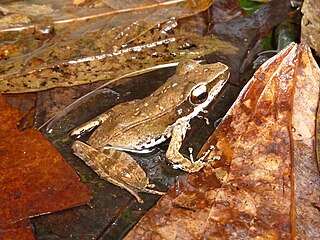The sky-blue poison frog is a species of poison dart frog. It is endemic to Peru and known from the lower eastern versant of the Andes in the upper Amazon basin of the San Martín Region.
Anstisia vitellina, commonly known as the orange-bellied frog, is a species of frog in the family Myobatrachidae. It is endemic to a 20 hectare area near Margaret River in Southwest Australia. It is vulnerable to extinction due to fire and the destruction of habitat caused by feral pigs.
Ranoidea vagitus, the wailing frog, is a species of tree frog occupying the arid and monsoonal Kimberley region. It is a ground dweller, which evades dry periods by burrowing and hibernating - emerging to breed during floods.
Anstisia alba, commonly known as the white-bellied frog, is a small frog in the family Myobatrachidae. It occupies an area near Margaret River in swampy depressions adjoining creeks. Threats from altered ecology have made this a critically endangered species of south-western Australia.
The Alagoas heart-tongued frog is a species of frog in the family Hylidae, the tree frogs and allies. It is endemic to Brazil, where it is known from coastal regions in Bahia, Alagoas, and Pernambuco.
Trachycephalus lepidus is a species of frogs in the family Hylidae endemic to Brazil. Its natural habitat is subtropical or tropical moist lowland forests. It is threatened by habitat loss. This species was previously within the genus Phrynohyas, which was recently synonymized with Trachycephalus.

Chacophrys pierottii, the Chaco horned frog or lesser Chini frog, is a species of frog in the family Ceratophryidae. It is monotypic within the genus Chacophrys. It is found in the Chaco of northern Argentina, eastern Bolivia, and western Paraguay. Its natural habitats are dry shrubland and gallery forest. Outside the breeding season adults remain buried underground but emerge during the first heavy rains to breed in temporary ponds.

Bahius is a genus of frog in the family Strabomantidae. It contains a single species, Bahius bilineatus.

Phantasmarana apuana is a species of frog in the family Hylodidae. It is endemic to Brazil. Its natural habitats are subtropical or tropical moist montane forest and rivers. It is threatened by habitat loss.
Scythrophrys is a genus of frogs in the family Leptodactylidae. It is monotypic, being represented by the single species, Scythrophrys sawayae, commonly known as the Banhado frog, after its type locality. It is endemic to Serra do Mar in Paraná and Santa Catarina states, south-eastern Brazil. Its natural habitats are secondary and old growth forests; reproduction takes place in temporary pools. Its populations are scattered but it is locally common. It is threatened by habitat loss. This species was first described in 1953 by the American herpetologist Doris Mable Cochran whose research was focused on the herpetofauna of the West Indies and South America.
The hooting frog is a species of frog in the family Limnodynastidae. It is endemic to Australia. Its natural habitats are temperate forests and intermittent rivers.
Pelobatrachus edwardinae is a species of frog in the family Megophryidae. It is commonly known as the rough horned frog, Edwardina's horned frog, and Edwardina's spadefoot toad. It is endemic to northern Borneo and known from the Sabah and Sarawak provinces of Malaysia as well as from Brunei. Its natural habitats are tropical moist lowland forests and rivers. It is threatened by habitat loss
Dasypops is a genus of frog in the family Microhylidae. It is monotypic, being represented by the single species, the Rio Mutum frog. It is endemic to the coastal plain of Espírito Santo and Bahia states of eastern Brazil. Its natural habitats are lowland forests, including secondary forests and forest edges. It is an explosive breeder that breeds in temporary pools. It is potentially threatened by habitat loss.
Phrynella is a genus of frogs in the family Microhylidae. It is monotypic, being represented by the single species, Phrynella pulchra. It is found in Indonesia, Malaysia, and Thailand. Its natural habitats are subtropical or tropical moist lowland forests and intermittent freshwater marshes. It is threatened by habitat loss.
Anstisia lutea is a species of frog in the family Myobatrachidae. It is sometimes named for the nearby towns, thus the Nornalup or Walpole frog. It is endemic to Southwest Australia, along with the other members of the genus Anstisia. It was formerly classified in the genus Geocrinia, but was reclassified into the new genus Anstisia in 2022.
The forest night frog is a species of frog in the family Nyctibatrachidae endemic to India. Its natural habitats are tropical moist lowland forests and rivers.
Pseudorana weiningensis is a species of true frog endemic to China. It is the only species in the genus Pseudorana. It is also known as the Weining frog or Weining groove-toed frog. Its natural habitats are temperate shrubland, temperate grassland, and rivers. It is threatened by habitat loss.
Rohanixalus shyamrupus, also known as the hornbill bubble-nest frog and Shyamrup's bush frog, is a species of frog in the family Rhacophoridae endemic to north-eastern India: it is only known from the type locality, Namdapha Tiger Reserve in Arunachal Pradesh.

The Puerto Rican rock frog, also known as the Puerto Rican cave-dwelling frog or rock coqui, and locally as coquí guajón, or guajón for brevity, is a threatened frog species from the coqui genus. This unique species of tropical frogs dwells primarily in crevices and grottos in the Cuchilla de Panduras mountain range in southeastern Puerto Rico. The native name guajón is derived from its habitat, guajonales, which are caves formed by rock formations between huge stones. Despite being the state animal and considered emblematic of the region, of the 17 species of coquí, three are believed to be extinct and the rest are rare and declining in numbers. The Puerto Rican rock frog is extremely restricted in geographical distribution. The frog is threatened due to deforestation, agricultural, rural, and industrial development, and the associated infrastructure. It is sometimes called the “demon of Puerto Rico" because of its eerie call and phantom-like appearance. The species was first described by American herpetologist, Chapman Grant in 1932.

Papurana celebensis, also known as the Celebes frog, is a species of true frog in the family Ranidae. Prior to being reclassified into the genus Papurana in 2020, it was referred to as "Hylarana" celebensis. It is endemic to Sulawesi (Celebes), Indonesia. It is a lowland forest species, also occurring disturbed habitats.





